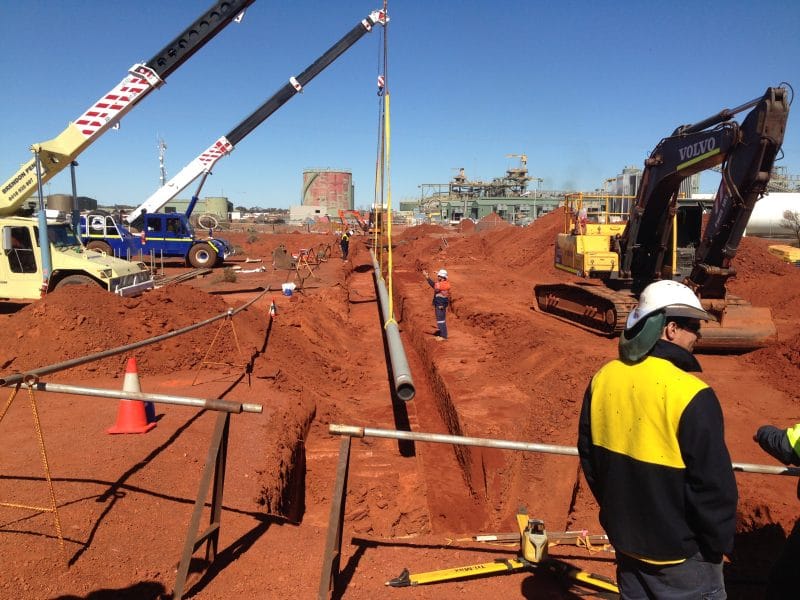Safety hazards can come from things that are unseen, with high pressure natural gas transmission pipelines potentially a catastrophic cause. APA Group raises the mining industry’s awareness of what needs to be considered before working in pipeline corridors.
More than 39,000 kilometres of natural gas transmission pipelines are sprawled across Australia, three times the distance between the country and the North Pole.
Energy infrastructure company APA Group owns and controls nearly 40 per cent of Australia’s pipelines and services many remote mine sites.
As the country’s largest transporter of natural gas, the company supplies and delivers around half of the nation’s annual gas usage through high pressure pipelines.
From outback locations to urban environments, the pipelines are built and operated to the highest standards to transport the gas safely and withstand human activities around them. But they are by no means immune to high-impact activities and rupture incidents.
“The right type of equipment and circumstances, such as vertical or horizontal boring and movement of large excavators across the pipelines, which aren’t designed to hold that kind of weight, can definitely rupture them, or cause damage leading to potential failure,” APA Group manager infrastructure protection, Ross Larsen, tells Safe to Work.
“Most damage that occurs to gas pipeline assets are done through third-party activities, whether that be drilling, blasting, excavation or construction. So people need to be aware of what’s below.”
APA’s transmission pipelines range from 300 millimetres to a metre in diameter. Depths typically range from 800 millimetres deep in rural areas, to 1.2 metres deep in residential environments.
They operate at up to 15,000 kilopascals (kPa), which is 50 times the pressure in a car tyre.
Australia has witnessed pipeline ruptures in the past, including a 1984 incident in Bibra Lake, Western Australia, when a bulldozer deep ripping activity led to a pipeline rupture.
The bulldozer was left running, causing gas to escape and ignite an explosion minutes later.
The incident led to the establishment of Dial Before You Dig in Australia, a national community service that aims to prevent damage and disruption to pipe and cable networks.
Around two decades later, a bulldozer ripper also caused a buried pipeline to rupture during construction work in Wyoming in the United States.
This sent blazes of flames to the air and led to the passing of the dozer operator.
According to non-profit organisation FracTracker Alliance, more than 5500 incidents, nearly 600 injuries and more than 125 fatalities and 800 fires were associated with United States gas pipelines between 2010 and late 2018.
Mobile equipment such as excavators, distant blasting operations and the development of access tracks across gas pipelines can all contribute to pipeline damage.
A ruptured pipeline is also at risk of exploding, according to Larsen, who says it could affect areas lying within hundreds of metres radius of the pipeline.
“The fire will continue burning for many hours due to the high volume of gas being carried,” Larsen says.
“Even if a pipeline doesn’t rupture, damage to it will likely compromise its integrity. For example, we have anti-corrosion protection (cathodic) along the lengths of our pipelines. But if that is damaged, corrosion can occur some distance away.
“People might know where the pipeline is, but there may be associated damage that doesn’t necessarily happen on the spot of impact and that’s something to be aware of.”
Larsen says there is a process for working safely in the vicinity of high-pressure gas pipelines.
Mine operators, borers and drillers, for example, should obtain APA approval when undertaking excavation, fibre optic cable installation, power poles installation or relocation and fencing works.
A blasting activity within 500 metres of the pipeline, trees planting and material storage on the APA pipeline corridors would also require permission.
Mine operators can lodge an enquiry online or call APA. If this indicates APA’s assets may be affected, APA will need to discuss the planned works with the enquirer. This will determine if the activity requires written authorisation to be issued prior to works commencing.
APA also offers face-to-face presentations with industry groups and companies that are interested in deepening their understanding about working safely around gas pipelines.
The company can also provide toolbox safety materials to help get the message out to workers.
Aside from its safety impact, damage to pipelines is something that mining companies want to avoid due to the significant costs associated with it.
“If an unauthorised activity has occurred close to our pipeline, we will usually need field works to determine how close the works have gone to it, and potentially expose the pipeline to determine the extent of any damage to the pipeline,” Larsen says.
“We patrol our pipelines regularly by ground and by air. We’re constantly looking for unauthorised works and trying to stop them before they occur, but if they do occur we will recover any associated costs from the responsible party.”
Larsen says fixing a damaged pipeline will incur costs of travel to the site, road closures and equipment transport. This is in addition to potential fines or prosecutions that could be attached to the incident.
“Our pipelines are protected under the state legislation of each Australian state. There’s also Safe Work legislation that people need to be aware of to ensure that they have demonstrated adequate duty of care, evaluating the impact of digging the ground and carrying out their activities,” Larsen says.
“People might think it takes time to do the proper investigation and planning before carrying out their works, but if we find an unauthorised activity, we’re obliged to stop them.
“It is best to plan ahead rather than facing a delay or interruption to their works, and that is the least of your concerns if the pipeline is struck or ruptured.”
This article also appears in the Mar-Apr issue of Safe to Work.



